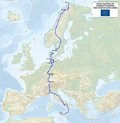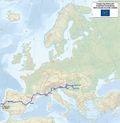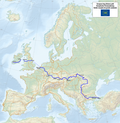This article has multiple issues. Please help improve it or discuss these issues on the talk page . (Learn how and when to remove these messages)
|
| E-paths | |
|---|---|
 | |
 | |
| System information | |
| Length | 65,000 km (40,000 mi) |
| Formed | 1995 |
| Highway names | |
| E-path | E nn |
| System links | |
The European long-distance paths (E-paths) are a network of long-distance footpaths that traverse Europe. While most long-distance footpaths on the continent are located in just one country or region, each of these numbered long-distance trails passes through many countries.
Contents
The first long-distance hiking trail in Europe was the National Blue Trail of Hungary, established in 1938. The formation of the European Union in 1993 made transnational hiking trails possible. Presently, the network consists of 12 paths and covers more than 65,000 kilometres (40,000 mi), crisscrossing the continent. In general, the routes connect and make use of existing national and local trails, such as the GR footpaths.
The trails are officially designated by the European Ramblers' Association.











